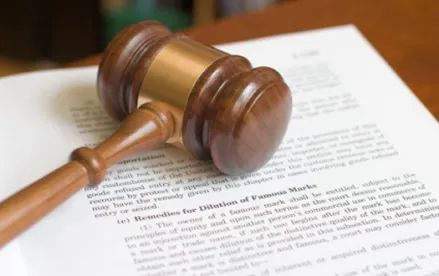It may be punny or even funny, but a unanimous Supreme Court has decided that the “Bad Spaniels” dog-toy brand may infringe and dilute the “Jack Daniel’s” trademark.[1]
Last week’s opinion puts an end to the toy maker’s attempt to invoke the Rogers test. The Second Circuit established that test in 1989 as a substitute for the traditional “likelihood of confusion” trademark-infringement test when a brand name (or similar equivalent) is purportedly used for “artistic expression.”[2] Justice Elena Kagan’s opinion limits the application of the Rogers test to evaluating only “non-trademark uses” of a brand, such as references in works of art (perhaps an Andy Warhol soup can[3]) where the name is used in a “non-source-identifying way.”[4] But where a name potentially connects a product with its maker in the mind of a consumer, the traditional trademark-infringement analysis applies—namely, whether there is a likelihood of consumer confusion.[5]
Under the Lanham Act (which is the “core federal trademark statute”), a trademark is “‘[a]ny word, name, symbol, or device, or any combination thereof’ that a person uses ‘to identify and distinguish her or her goods . . . from those manufactured or sold by others and to indicate the source of the goods.”‘[6] Trademarks, therefore, can be words (“Google”), symbols (Nike’s swoosh), sounds (the NBC chime), colors (Target’s red), or even “the overall appearance of a product and its packaging” (the Hershey’s Kiss wrapper).[7] And the core function of a trademark is “to identify the origin or ownership of the article to which [the mark] is affixed.”[8] “In other words, a mark tells the public who is responsible for a product.”[9] Accordingly, the core inquiry for trademark infringement under the Lanham Act is whether a defendant’s use of a name or brand is “likely to cause confusion.”[10]
Here, the Supreme Court addressed a dispute between VIP Products LLC (“VIP”) and Jack Daniel’s Properties, Inc. (“Jack Daniel’s”) over VIP’s use of the name “Bad Spaniels” for dog toys.[11] By way of background, VIP sells squeaky dog toys called “Silly Squeakers” that look like the products of alcoholic beverage brands under names that parody those brands: “Dos Perros” instead of “Dos Equis”; “Smella Arpaw” instead of “Stella Arois,” among others.[12] The resemblance between a bottle of Jack Daniel’s whisky and VIP’s dog toy is undeniable:[13]


In addition to substituting the name Bad Spaniels for Jack Daniel’s, phrases such as “The Old No. 2 On Your Tennessee Carpet” and “43% poo by vol.” replace “Old No. 7 Tennessee Sour Mash Whiskey” and “40% alc. by vol. (80 proof).”[14] VIP’s attached product label also carries product logos for Silly Squeakers and Bad Spaniels and a disclaimer that “[t]his product is not affiliated with Jack Daniel’s Distillery.”[15]
After VIP began selling the Bad Spaniels toy, Jack Daniel’s sent VIP a cease-and-desist letter. VIP responded by filing a lawsuit, seeking a declaration that the Bad Spaniels name did not infringe or dilute the Jack Daniel’s mark, and Jack Daniel’s countersued for trademark infringement and dilution.[16] On summary judgment, VIP argued that the First Amendment protected its use of “expressive works” such as the Bad Spaniels toy. That is, VIP contended that the “Rogers test requires dismissal of an infringement claim at the outset unless the complainant can show one of two things: that the challenged use of a mark ‘has no artistic relevance to the underlying work’ or that it ‘explicitly misleads as to the source or the content of the work.’”[17] The trial court disagreed and Jack Daniel’s won its bench trial against VIP by showing that consumers were likely to be confused about the source of the Bad Spaniels toy. But the Ninth Circuit reversed, holding that the trial court erred by not applying the Rogers test, and on remand, the trial court reversed its judgment.[18]
Now, in what it calls a “narrower path,”[19] the Supreme Court has ruled that the Rogers test is all bark and no bite where an allegedly infringing name is used as a source identifier. That is, the Rogers test has no merit and does not apply “when an alleged infringer uses a trademark in the way the Lanham Act most cares about: as a designation of source for the infringer’s own goods.”[20]The First Amendment does not override the Lanham Act when the infringing mark is meant to—at least in part—help consumers decide to pick the infringing good versus another one in the market.[21] In colorful terms: “Whatever first amendment rights you may have in calling the brew you make in your bathtub ‘Pepsi’ are outweighed by the buyer’s interest in not being fooled into buying it.”[22] Here, the Bad Spaniels name and logo was prevalent not just on the squeaky bottle but also on the toy’s product tag opposite the toy maker’s own logo. So, even if the name was an artistic dig at Jack Daniel’s, because the Bad Spaniels name was a source identifier for the toy, the traditional likelihood-of-confusion test is the one that applies.[23]
Key Takeaways:
-
Simply communicating an expressive message (in this case, humor in the form of questionably bad puns) is not automatically entitled to Rogers protection.[24] Such a broad application of Rogers “‘potentially encompasses just about everything.’”[25]
-
The Court recognized the importance of trademark rights, generally holding that trademark law prevails over the First Amendment when another’s trademark (or a confusingly similar mark) is used without permission as a source identifier (i.e., a trademark).[26]
-
VIP’s complaint stated that VIP owns and uses the Bad Spaniels trademark.[27] The Court took this as a concession that VIP used the mark as a source identifier.[28] Those intending to rely on the Rogers test should be careful to treat such use as strictly non-source-identifying both in practice and in pleadings.
[1] Jack Daniel’s Properties, Inc. v. VIP Products LLC, No. 22-148, 599 U.S. ____, ___ S.Ct. ____, ___ L.Ed.2d ____, 2023 WL 3872519 (June 8, 2023). Click here to read the opinion.
[2] See Rogers v. Grimaldi, 875 F.2d 994 (2d Cir. 1989). The Rogers test has since been adopted by the Third, Fifth, Sixth, Ninth, and Eleventh Circuits as well as by district courts in the Seventh and Tenth Circuits. See Lynn M. Jordan and David M. Kelly, Another Decade of Rogers v. Grimaldi: Continuing to Balance the Lanham Act with the First Amendment Rights of Creators of Artistic Works, 109 T.M.R. 833, 834–35 (2019).
[3] Though the Court does not refer to its opinion in the Andy Warhol copyright infringement case from a few weeks ago, Warhol’s use of the Campbell’s Soup trademark in his paintings of soup cans seems to be a fitting (and timely) example. See Andy Warhol Foundation for the Visual Arts, Inc. v. Goldsmith, 143 S.Ct. 1258, 1281 (2023) (“The purpose of Campbell’s logo is to advertise soup. Warhol’s canvases do not share that purpose. Rather, the Soup Cans series uses Campbell’s copyrighted work for an artistic commentary on consumerism, a purpose that is orthogonal to advertising soup.”); see also Jonathon K. Hance and Drew Taggart, Supreme Court Rules Andy Warhol's Famous “Orange Prince” May Be Copyright Infringement; Jonathon K. Hance, Supreme Court Takes Up Andy Warhol's "Prince Series" Fair Use Circuit Split; Jonathon K. Hance and Douglas F. Stewart, Artists Beware–Second Circuit Holds That Andy Warhol's "Prince Series" Is Not a "Fair Use" of Copyrighted Photograph. Another example is the use of the Louis Vuitton brand by a character in The Hangover: Part II (pronounced “Lewis” Vuitton in that instance); there all parties agreed that the film’s character was not using the brand name as a source identifier for the film. See Jack Daniel’s Properties, Inc., 2023 WL 3872519, at *7 (providing this and other examples).
[4] Id. at *8.
[5] Id. at *8, *11
[6] Id. at *3 (quoting 15 U.S.C. § 1127) (alteration in original).
[7] Id. (providing examples of types of trademarks).
[8] Id. (internal quotation marks omitted).
[9] Id.
[10] Id. at *4. The Lanham Act also creates a cause of action for dilution of famous marks, which was also at issue in the Jack Daniel’s case. Id. (citing 11 U.S.C. § 1125(c)).
[11] Id. at *3.
[12] Id. at *5.
[13] Id.
[14] Id.
[15] Id.
[16] Id.
[17] Id. at *6 (citing Rogers, 875 F.2d at 999).
[18] Id.
[19] Id.
[20] Id. (noting that the Court is not deciding whether the Rogers test has merit in other contexts).
[21] See id. at *8.
[22] Id. at *9 (quoting Mattel, Inc. v. MCA Records, Inc., 296 F.3d 894, 900 (9th Cir. 2002)) (cleaned up).
[23] Id. at *10. The Court also rejected Bad Spaniels’ attempt to invoke the “fair use” (i.e., noncommercial) exclusion to a trademark dilution claim. “However wide the scope of the ‘noncommercial use” exclusion, it cannot include . . . every parody or humorous commentary.” Id. at *10.
[24] Id. at *9.
[25] Id. (quoting 6 McCarthy, Trademarks and Unfair Competition § 31:144.50 (5th ed. 2023)).
[26] See id.
[27] Id.
[28] Id.




 />i
/>i
